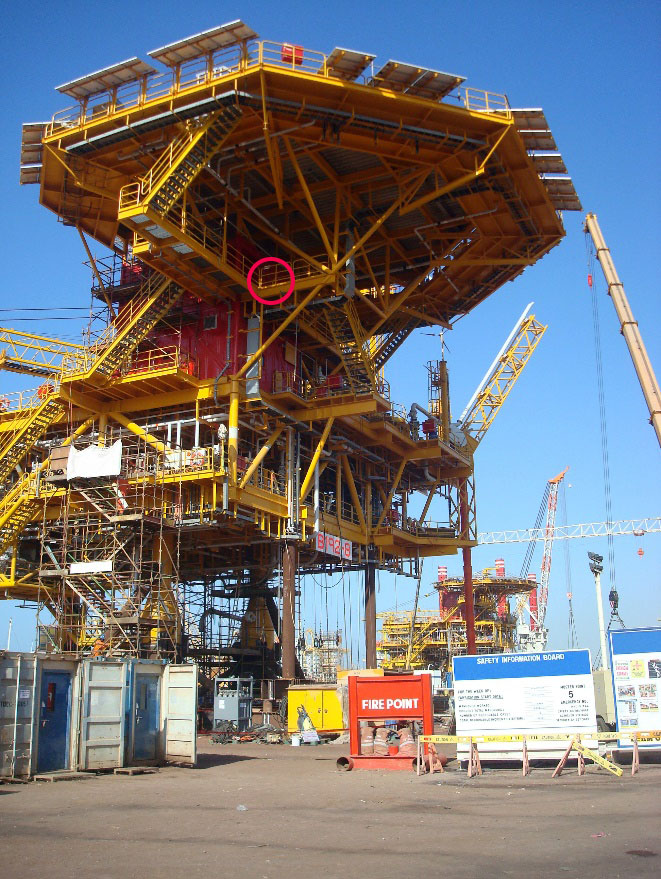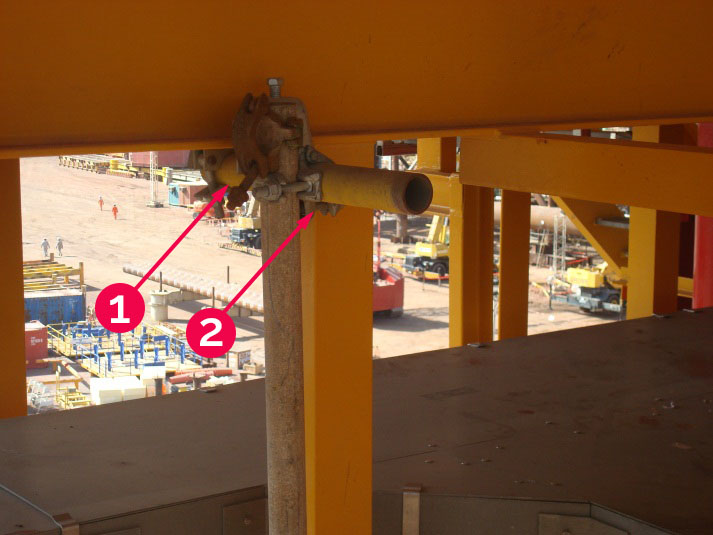Lost time injury (LTI): Fall from height leading to multiple fractures
A member has reported an incident in which a worker fell 16m and sustained multiple fractures. The incident occurred when the worker was part of a team dismantling a hanging scaffold on part of a topsides under construction in the yard. The sequence of work meant that scaffolders dismantling the structure ended up supported on the bottom of the droppers (scaffold tubes attached to deck structure to support hanging scaffold). The worker was climbing the dropper to tie off his safety harness to the deck structure when the dropper slipped through the couplers and fell 16m with him attached. He sustained multiple fractures and was taken to hospital.


With regard to scaffolding, the following points were made:
- The dropper support coupler is attached to a horizontal tube;
- A second coupler is attached above the support coupler to act as a safety or check coupler;
- The purpose of the safety coupler is to support the dropper should the support coupler become loose;
- In this incident both coupler connections on the dropper became loose allowing the dropper to slide through both couplers and fall.
An investigation revealed the following causal factors:
- Primary support and safety couplers became loose and failed to support the dropper and the injured person;
- Fall arrest lanyard was connected to the dropper as no consideration had been given to fall arrest being independently tied off from the scaffold, e.g. inertia reel attached to the deck structure;
- No checks were made of the tightness of safety critical couplers after deck stacking and subsequently over a prolonged period (12-14 weeks);
- Partially dismantled scaffold indicated lax control of earlier activities;
- Supervisory personnel in attendance did not correct unsafe working at height practices and require an independent tie off;
- The task was not planned or risk assessed adequately.
The following recommendations and corrective actions were made:
- When dismantling hanging scaffold always connect the fall arrest to a structure independent of the scaffold being dismantled;
- Where no independent structure is in reach of personal fall arrest lanyards, or a greater degree of movement is required, use an inertia reel;
- Always check tightness of dropper support and safety couplers:
- after stacking or moving of decks and structures when scaffold is pre-installed
- after any alterations are made
- after high wind
- after it has been erected more than 30 days
- before dismantling of scaffold.
Safety Event
Published: 15 February 2013
Download: IMCA SF 04/13
IMCA Safety Flashes
Submit a Report
IMCA Safety Flashes summarise key safety matters and incidents, allowing lessons to be more easily learnt for the benefit of all. The effectiveness of the IMCA Safety Flash system depends on Members sharing information and so avoiding repeat incidents. Please consider adding [email protected] to your internal distribution list for safety alerts or manually submitting information on incidents you consider may be relevant. All information is anonymised or sanitised, as appropriate.
IMCA’s store terms and conditions (https://www.imca-int.com/legal-notices/terms/) apply to all downloads from IMCA’s website, including this document.
IMCA makes every effort to ensure the accuracy and reliability of the data contained in the documents it publishes, but IMCA shall not be liable for any guidance and/or recommendation and/or statement herein contained. The information contained in this document does not fulfil or replace any individual’s or Member's legal, regulatory or other duties or obligations in respect of their operations. Individuals and Members remain solely responsible for the safe, lawful and proper conduct of their operations.
